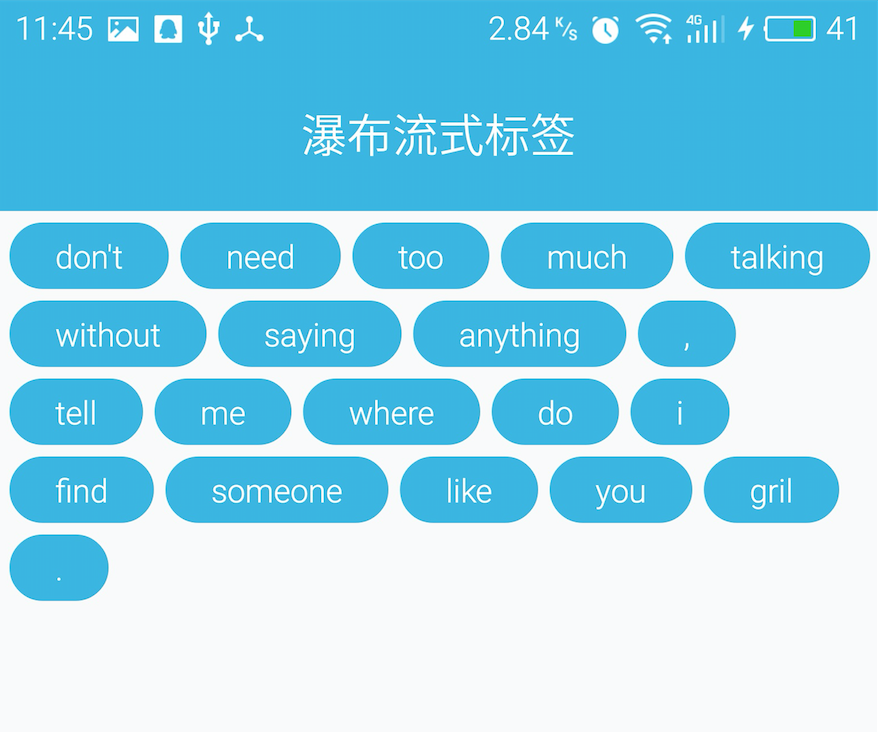实现背景
打造Android中的流式布局和热门标签
看到鸿洋大神的这个视频教程有感而发,于是自己重新写了一遍这个viewgroup,大体思路一致,不过关键地方改成了我自己比较容易理解的算法:
对于标签直接的间距,鸿洋大神用的是给标签设置margin的方式,而我用的是对ViewGroup的自定义水平间距、垂直间距的方式;
onLayout中,鸿洋大神先是判断标签的换行情况,然后再将每个标签依次摆放,其实判断标签换行的这个操作在onMeasure里面就已经执行过了,如果在onLayout再次判断换行计算宽高什么的,各种计算感觉很麻烦,容易出错,所以理解感觉好费劲,之前一直觉得他那种方法很烧脑,毕竟对于我这种菜鸟来说是跟不上大神的思维的;(我这算不算王婆卖瓜自卖自夸?)
使用步骤
先看这个自定义ViewGroup的用法:
- 在attr.xml中声明如下自定义属性:
<?xml version="1.0" encoding="utf-8"?>
<resources>
<attr name="horizontal_diver" format="dimension"/>
<attr name="vertical_diver" format="dimension"/>
<declare-styleable name="FlowTagLayout">
<attr name="horizontal_diver"/>
<attr name="vertical_diver"/>
</declare-styleable>
</resources>- 布局文件中声明xmlns
xmlns:flowtag="http://schemas.android.com/apk/res-auto"- 然后就能直接使用了
<com.passerby.androidadvanced.customviewgroup.FlowTagLayout
android:id="@+id/flowTagLayout"
android:layout_width="match_parent"
android:layout_height="wrap_content"
flowtag:horizontal_diver="5dp"
flowtag:vertical_diver="5dp">
</com.passerby.androidadvanced.customviewgroup.FlowTagLayout>- java代码中直接addView即可
for (String tag : tagArr) {
TextView textView = makeTextView();
textView.setText(tag);
mFlowTagLayout.addView(textView);
}是不是很简单。
源码解析
对于瀑布流标签的实现算法,鸿洋大神在视频教程里面已经说明的很清楚了,大家如果觉得文字性的东西比较难懂可以先去看他的视频,我要讲的算法跟他差不多,不过我会更多的描述跟自定义view有关的知识。
源码如下:
package com.passerby.androidadvanced.customviewgroup;
import android.content.Context;
import android.content.res.TypedArray;
import android.text.TextUtils;
import android.util.AttributeSet;
import android.util.Log;
import android.view.View;
import android.view.ViewGroup;
import com.passerby.androidadvanced.R;
import java.util.ArrayList;
import java.util.List;
/**
* Created by mac on 16/1/28.
*/
public class FlowTagLayout extends ViewGroup {
private List<List<View>> mChildViews;
private List<Integer> mLinesHeight;
private int mHorizontalDiver, mVerticalDiver;
public FlowTagLayout(Context context) {
this(context, null);
}
public FlowTagLayout(Context context, AttributeSet attrs) {
this(context, attrs, 0);
}
public FlowTagLayout(Context context, AttributeSet attrs, int defStyleAttr) {
super(context, attrs, defStyleAttr);
mChildViews = new ArrayList<>();
mLinesHeight = new ArrayList<>();
TypedArray a = context.getTheme().obtainStyledAttributes(attrs, R.styleable.FlowTagLayout, defStyleAttr, 0);
int count = a.getIndexCount();
for (int i = 0; i < count; i++) {
int index = a.getIndex(i);
switch (index) {
case R.styleable.FlowTagLayout_horizontal_diver:
mHorizontalDiver = (int) a.getDimension(i, 0);
break;
case R.styleable.FlowTagLayout_vertical_diver:
mVerticalDiver = (int) a.getDimension(i, 0);
break;
}
}
a.recycle();
}
//只需要计算AT_MOST模式下的宽高;如果是EXACTLY模式,则直接根据ViewParent传进来的值进行设置就好
@Override
protected void onMeasure(int widthMeasureSpec, int heightMeasureSpec) {
int widthMode = MeasureSpec.getMode(widthMeasureSpec);
int widthSize = MeasureSpec.getSize(widthMeasureSpec);
int heightMode = MeasureSpec.getMode(heightMeasureSpec);
int heightSize = MeasureSpec.getSize(heightMeasureSpec);
mChildViews.clear();
mLinesHeight.clear();
//AT_MOST模式下计算出来的宽和高
int atmostWidth = 0, atmostHeight = 0;
int lineWidth = 0, lineHeight = 0;
List<View> lineChilds = new ArrayList<>();
int childCount = getChildCount();
for (int i = 0; i < childCount; i++) {
View child = getChildAt(i);
measureChild(child, widthMeasureSpec, heightMeasureSpec);
int childWidth = child.getMeasuredWidth() + mHorizontalDiver;
int childHeight = child.getMeasuredHeight() + mVerticalDiver;
if (lineWidth + childWidth < widthSize) {
//如果不需要换行,则直接将该child的宽度累加到改行的宽度中
lineWidth += childWidth;
//以高度最大的child的高度作为本行的高度
lineHeight = Math.max(lineHeight, childHeight);
lineChilds.add(child);
} else {
//如果需要换行,则计算出上一行的宽度跟上一行之前的宽度的较大值
atmostWidth = Math.max(atmostWidth, lineWidth);
//保存新行的第一个child的宽度
lineWidth = childWidth;
//叠加上一行的高度
atmostHeight += lineHeight;
//保存上一行的高度
mLinesHeight.add(lineHeight);
//保存上一行的所有child
mChildViews.add(lineChilds);
//新起一行
lineChilds = new ArrayList<>();
//保存新行的第一个child
lineChilds.add(child);
}
//处理最后一个
if (i == childCount - 1) {
atmostWidth = Math.max(atmostWidth, lineWidth);
atmostHeight += lineHeight;
mLinesHeight.add(lineHeight);
mChildViews.add(lineChilds);
}
}
int finalWidth = widthMode == MeasureSpec.EXACTLY ? widthSize : atmostWidth;
int finalHeight = heightMode == MeasureSpec.EXACTLY ? heightSize : atmostHeight;
v(String.format("width=%s,height=%s", finalWidth, finalHeight));
setMeasuredDimension(finalWidth, finalHeight);
}
@Override
protected void onLayout(boolean changed, int l, int t, int r, int b) {
int left = 0, top = 0;
int lineCount = mChildViews.size();
for (int i = 0; i < lineCount; i++) {
List<View> childs = mChildViews.get(i);
int childCount = childs.size();
for (int j = 0; j < childCount; j++) {
View child = childs.get(j);
int childWidth = child.getMeasuredWidth();
int childHeight = child.getMeasuredHeight();
child.layout(left + mHorizontalDiver,
top + mVerticalDiver,
left + mHorizontalDiver + childWidth,
top + mVerticalDiver + childHeight);
left += mHorizontalDiver + childWidth;
}
//重置left到最左
left = 0;
//累加每行的高度,不能重置
top += mLinesHeight.get(i);
}
}
protected void v(String msg) {
final String text = msg;
if (!TextUtils.isEmpty(text)) {
Log.v(getClass().getCanonicalName(), text);
}
}
}注释写的很清楚了,我只挑一部分说明。
代码39~54行是从布局文件中读取自定义属性的值。因为声明自定义属性的时候就是用的dimension格式,所以我们读取的时候直接用getDimension()来获取值即可;如果声明自定义属性的时候用的是Integer,那你用getInteger()来获取值之后,还需要将它转成px,因为自定义view计算各种距离、文字大小都是基于px的。
如果有人之前用paint.drawText()的时候感觉画出来的文字大小不对,那看到这你应该能知道原因了。
说完构造方法,就剩下onMeasure和onLayout了。在onMeasure中我分别使用 mChildViews、mLinesHeight这两个ArrayList来保存所有的子view以及每行标签的高度。
对于mChildViews这个集合,你可以把它想象成一个二维数组,mChildViews取出来的每个元素仍然是一个ArrayList,表示的是某一行的所有标签的view。
对于mLinesHeight,它的作用是为了便于在onLayout中遍历mChildViews的每行标签时提供改行高度的位置参考。
代码105~111行,为什么这里要单独处理最后一个?说准确一点其实这里处理的是最后一行。
你可以假设现在这个ViewGroup里面的标签行数只有一行,也就是说没有达到换行的条件,即没有走到onMeasure中的else那个分支,我们上面累加每行标签的高度、以及保存每行标签子view的时候都是在那个else里面完成的,现在标签数目没有足够换行,那不是意味着这行的行高以及所有的子view都没有被添加进来吗?
这将导致onMeasure方法最后计算出来的宽高并不准确,对于后面的onLayout方法当然也无法正确的被执行。
代码113~118行,计算宽高完成之后不要忘了设置计算出来的值,那两种计算模式应该不用多讲了吧。
再看onLayout,其实很简单了,因为复杂的操作以及在onMeasure中完成了。
两个for循环就是遍历之前存的mChildViews,你可以把它想象成一个二维数组,先取出第0行,然后遍历这行的所有标签,用child.layout来完成该标签的布局。以此类推。
child.layout方法的完整声明如下
public void layout(int l, int t, int r, int b)
- l : 子view的左边相对于父容器左边的距离
- t : 子view的顶部相对于父容器顶部的距离
- r :子view的右边相对于父容器左边的距离
- b:子view的底部相对于父容器顶部的距离
基本上就说完了,大家如果不明白的话,建议去看看上面的那个视频教程,如果还不明白,建议自己动手试试。
欢迎大家交流意见。























 975
975











 被折叠的 条评论
为什么被折叠?
被折叠的 条评论
为什么被折叠?








